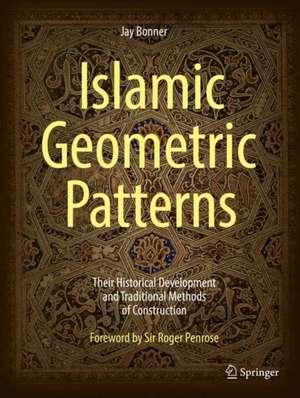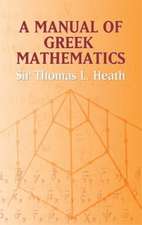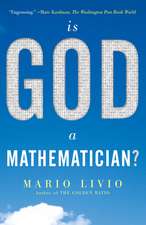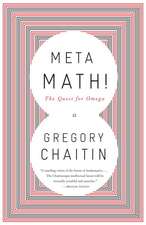Islamic Geometric Patterns: Their Historical Development and Traditional Methods of Construction
Autor Jay Bonner Contribuţii de Craig Kaplanen Limba Engleză Hardback – 19 aug 2017
Featuring over 600 beautiful color images, Islamic Geometric Patterns: Their Historical Development and Traditional Methods of Con
struction is a valuable addition to the literature of Islamic art, architecture and geometric patterns. This book is ideal for students and scholars of geometry, the history of mathematics, and the history of Islamic art, architecture, and culture. In addition, artists, designers, craftspeople, and architects will all find this book an exceptionally informative and useful asset in their fields.Jay Bonner is an architectural ornamentalist and unaffiliated scholar of Islamic geometric design. He received his MDes from the Royal College of Art in London (1983). He has contributed ornamental designs for many international architectural projects, including the expansion of both the al-Masjid al-Haram (Grand Mosque) in Mecca, and the al-Masjid an Nawabi (Prophet’s Mosque) in Medina, as well the Tomb of Sheikh Hujwiri in Lahore, and the Ismaili Centre in London – to name but a few. He is committed to the revitalization of Islamic geometric design through the teaching of traditional methodological practices. To this end, in addition to publishing, Jay Bonner has lectured and taught design seminars at many universities and conferences in North America, Europe, North Africa and Asia.
| Toate formatele și edițiile | Preț | Express |
|---|---|---|
| Paperback (1) | 624.70 lei 38-44 zile | |
| Springer – 3 aug 2018 | 624.70 lei 38-44 zile | |
| Hardback (1) | 1655.31 lei 38-44 zile | |
| Springer – 19 aug 2017 | 1655.31 lei 38-44 zile |
Preț: 1655.31 lei
Preț vechi: 2149.76 lei
-23% Nou
Puncte Express: 2483
Preț estimativ în valută:
316.84€ • 344.28$ • 266.32£
316.84€ • 344.28$ • 266.32£
Carte tipărită la comandă
Livrare economică 16-22 aprilie
Preluare comenzi: 021 569.72.76
Specificații
ISBN-13: 9781441902160
ISBN-10: 1441902163
Pagini: 595
Ilustrații: XXV, 595 p. 540 illus., 507 illus. in color.
Dimensiuni: 210 x 279 x 45 mm
Greutate: 16.83 kg
Ediția:1st ed. 2017
Editura: Springer
Colecția Springer
Locul publicării:New York, NY, United States
ISBN-10: 1441902163
Pagini: 595
Ilustrații: XXV, 595 p. 540 illus., 507 illus. in color.
Dimensiuni: 210 x 279 x 45 mm
Greutate: 16.83 kg
Ediția:1st ed. 2017
Editura: Springer
Colecția Springer
Locul publicării:New York, NY, United States
Cuprins
Forward.- Preface and Acknowledgements.- 1. The Historical Antecedents, Initial Development, Maturity and Dissemination of Islamic Geometric Patterns.- 2. Differentiation: Geometric Diversity and Design Classification.- 3. Polygonal Design Methodology.- 4. Computer Algorithms for Star Pattern Construction.- References.- References.- Glossary.- Index.- Photographic Credits.
Recenzii
“More than 600 excellent photographs and figures support the discussion throughout. This text represents a substantial contribution to the study of Islamic design. For any serious collection. Summing Up: Highly recommended. Upper-division undergraduates through faculty and professionals.” (J. McCleary, Choice, Vol. 55 (10), June, 2018)
“This extensive volume by Jay Bonner on Islamic geometric patterns stands as probably one of the most comprehensive works on tessellation printed in recent years. … This richly illustrated book, with 105 photographs and over 540 illustrations, reviews the principles and techniques associated with this art form in the Islamic world … this book has the unexpected but dynamic quality of a knowledge-based forum where a well-informed scholar defends a particular thesis on the medium.” (Jean Constant, Mathematical Reviews, April, 2018)
“The book is very carefully edited, especially the graphics are extremely nice and very informative. … It is an artistic designers (hand)book for Islamic(-like) geometric patterns.” (Adhemar Bultheel, European Mathematical Society, euro-math-soc.eu, March 2018)
Textul de pe ultima copertă
The main focus of this unique book is an in-depth examination of the polygonal technique; the primary method used by master artists of the past in creating Islamic geometric patterns. The author details the design methodology responsible for this all-but-lost art form and presents evidence for its use from the historical record, both of which are vital contributions to the understanding of this ornamental tradition. Additionally, the author examines the historical development of Islamic geometric patterns, the significance of geometric design within the broader context of Islamic ornament as a whole, the formative role that geometry plays throughout the Islamic ornamental arts (including calligraphy, the floral idiom, dome decoration, geometric patterns, and more), and the underexamined question of pattern classification.
Featuring over 600 beautiful color images, Islamic Geometric Patterns: Their Historical Development and Traditional Methods of Construction is
a valuable addition to the literature of Islamic art, architecture and geometric patterns. This book is ideal for students and scholars of geometry, the history of mathematics, and the history of Islamic art, architecture, and culture. In addition, artists, designers, craftspeople, and architects will all find this book an exceptionally informative and useful asset in their fields.Jay Bonner is an architectural ornamentalist and unaffiliated scholar of Islamic geometric design. He received his MDes from the Royal College of Art in London (1983). He has contributed ornamental designs for many international architectural projects, including the expansion of both the al-Masjid al-Haram (Grand Mosque) in Mecca, and the al-Masjid an Nawabi (Prophet’s Mosque) in Medina, as well the Tomb of Sheikh Hujwiri in Lahore, and the Ismaili Centre in London – to name but a few. He is committed to the revitalization of Islamic geometric design through the teaching of tradi
tional methodological practices. To this end, in addition to publishing, Jay Bonner has lectured and taught design seminars at many universities and conferences in North America, Europe, North Africa and Asia.
Featuring over 600 beautiful color images, Islamic Geometric Patterns: Their Historical Development and Traditional Methods of Construction is
a valuable addition to the literature of Islamic art, architecture and geometric patterns. This book is ideal for students and scholars of geometry, the history of mathematics, and the history of Islamic art, architecture, and culture. In addition, artists, designers, craftspeople, and architects will all find this book an exceptionally informative and useful asset in their fields.Jay Bonner is an architectural ornamentalist and unaffiliated scholar of Islamic geometric design. He received his MDes from the Royal College of Art in London (1983). He has contributed ornamental designs for many international architectural projects, including the expansion of both the al-Masjid al-Haram (Grand Mosque) in Mecca, and the al-Masjid an Nawabi (Prophet’s Mosque) in Medina, as well the Tomb of Sheikh Hujwiri in Lahore, and the Ismaili Centre in London – to name but a few. He is committed to the revitalization of Islamic geometric design through the teaching of tradi
tional methodological practices. To this end, in addition to publishing, Jay Bonner has lectured and taught design seminars at many universities and conferences in North America, Europe, North Africa and Asia.
Caracteristici
Valuable asset to mathematicians, historians, artists, designers, craftspeople and architects Unique, in-depth presentation of the polygonal technique, featuring evidence from the historical record and exposition of the methodology behind the dead art form Comprehensive bibliography, index and geometric pattern appendix Broad view of historical development of Islamic ornament Includes supplementary material: sn.pub/extras Includes supplementary material: sn.pub/extras























